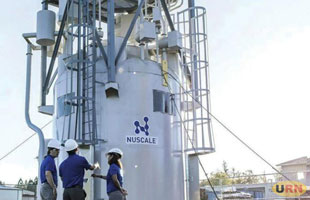By THE INDEPENDENT UG
ANALYSIS | THE INDEPENDENT | High Assay Low Enriched Uranium (HALEU) is gaining popularity in some developed countries as a more cost-effective fuel for establishing nuclear power plants. The current fleet of nuclear reactors primarily operates on uranium fuel enriched up to 5% uranium-235 (U-235).
This fuel option is particularly being advocated for as Uganda prepares to construct its nuclear power plant, especially for Small Modular Reactors (SMRs) with a capacity of up to 300 MW(e) per unit.
Nuclear energy plays a significant role in Uganda’s Energy Transition Plan, launched in December 2023, with plans to have its first 2000-megawatt nuclear power plant operational by the end of 2031.
However, the proposed nuclear plant, estimated to cost over nine billion dollars, has faced opposition from some experts. They suggest that countries like Uganda, despite having substantial uranium deposits, should consider the deployment of Small Modular Reactors (SMRs).
“It’s crucial to recognize that both large and small reactors come with their own advantages and disadvantages. Each country must carefully consider its unique needs and circumstances when deciding which option to pursue. In the case of Africa, financial, political, and infrastructure challenges hinder the adoption of large-scale nuclear power plants,” noted a report.
The emergence of High Assay Low Enriched Uranium provides Uganda with an alternative. The nuclear power plant is expected to contribute to Uganda’s electricity generation mix by 2031, as outlined in the Nuclear Power Roadmap Development Strategy and Vision 2040. The vision aims to achieve 30,000 Megawatts of nuclear power by 2026, requiring a substantial investment.
Small Modular Reactors (SMRs) are gaining traction due to their lower generating capacity compared to traditional nuclear power reactors. SMRs can produce a significant amount of low-carbon electricity.
The International Atomic Energy Agency (IAEA) highlighted the potential of HALEU in the deployment of nuclear energy technology. HALEU fuel enables smaller designs, longer operating cycles, and increased efficiencies, according to Olena Mykolaichuk, Director of the Division of Nuclear Fuel Cycle and Waste Technology at the IAEA.
At the UN Climate Change Conference in Dubai, over 22 countries called for advancing the aspirational goal of tripling nuclear power capacity by 2050. The potential of HALEU was underscored, emphasizing its role in the world’s second-largest source of clean electricity.
While HALEU is currently produced in Russia and the United States, efforts are being made in the UK and the United States to reduce dependence on imports. The UK has allocated £300 million to develop HALEU, aiming to enhance energy security.
The United States Nuclear Regulatory Commission authorized the start-up of HALEU operations in Ohio, marking a critical step in producing advanced fuels for the next generation of nuclear reactors.
The Euratom Supply Agency recommends that the European Union develops its capacity to produce HALEU fuel due to concerns over the future security of supplies. The agency estimates that, by 2035, the EU will need between 700 kilograms and a ton of HALEU each year to keep its research reactors in operation.
Nuclear power, after a decline following the Fukushima disaster, has been identified by the International Energy Agency (IEA) as having an opportunity for a comeback in the context of the global energy crisis, rising fossil fuel prices, energy security challenges, and ambitious climate commitments.
****
URN







Discussion about this post